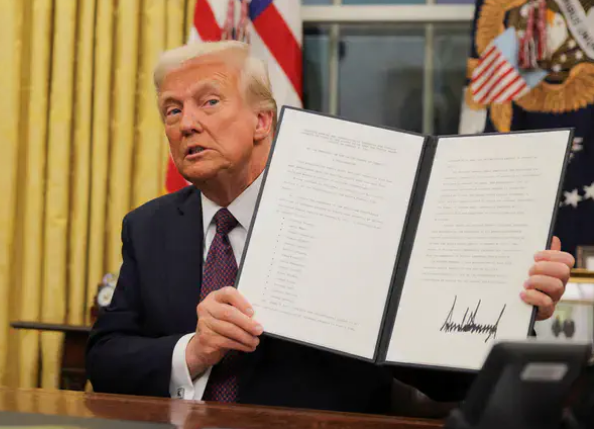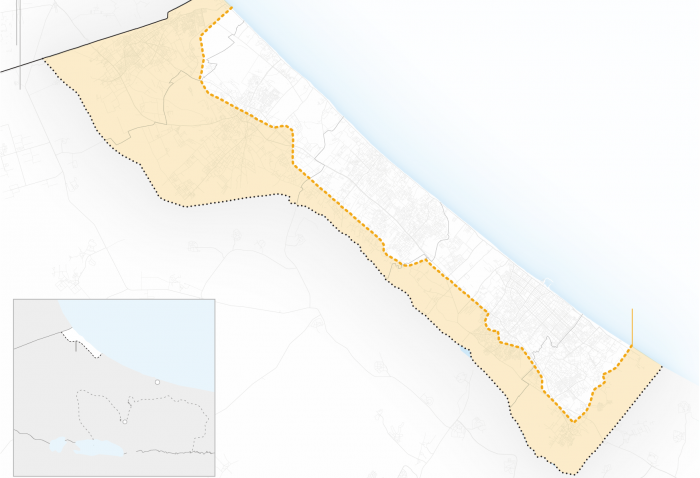As Trump’s sweeping global tariffs face Supreme Court review, American manufacturers scramble to adapt to permanent trade realignment and rising costs.
In what economists are calling a “revolutionary trade reset,” U.S. President Donald Trump’s global tariff regime — spanning dozens of allies and rivals — has upended decades of supply chain logic and thrust America’s industrial sector into a historic realignment.
For companies like OTC Industrial Technologies, a major factory-equipment producer based in Ohio, the economic shockwaves are palpable. “We moved production out of China to other countries — and now the tariffs on those are just as bad or worse,” lamented CEO Bill Canady. “We just have to hang on and survive so we don’t all go broke in the short run.”
His struggle mirrors the growing anxiety of American manufacturers, trade officials, and foreign ministries worldwide as the U.S. Supreme Court prepares to hear arguments this week on the legality of Trump’s aggressive tariff expansion — a case that could permanently redefine the limits of presidential trade power.
Trump’s Economic War Doctrine: “Reciprocal or Nothing”
At the heart of the legal battle is Trump’s unprecedented use of the 1977 International Emergency Economic Powers Act (IEEPA) — a law originally designed for national security sanctions — to impose sweeping global tariffs. Declaring the $1.2 trillion U.S. trade deficit and fentanyl overdoses as national emergencies, Trump invoked IEEPA to justify tariffs of up to 25% on countries accused of “economic aggression.”
“For decades, our country has been looted and plundered by nations near and far, both friend and foe alike,” Trump thundered in April. “Reciprocal means they do to us — and we do it to them.”
If the Supreme Court strikes down his authority under IEEPA, Trump’s Treasury Secretary Scott Bessent said the administration will simply pivot to other statutes, including Section 122 of the 1974 Trade Act (allowing 15% tariffs for 150 days) and Section 338 of the 1930 Tariff Act (permitting 50% tariffs against countries that discriminate against U.S. commerce).
“You should assume they’re here to stay,” Bessent said flatly. “We’ll call it whatever we need to call it so it’s not challengeable.”
A Global Ripple Effect — and America’s Leverage
Trump’s tariffs have become a powerful diplomatic weapon, forcing long-time trading partners into concessions to avoid harsher levies. The administration has finalized framework trade deals with Vietnam, Malaysia, Thailand, and Cambodia, setting tariffs at 19–20%, while South Korea agreed to a $350 billion investment package to unlock a 15% tariff rate on key exports.
In Beijing, Trump negotiated a delicate truce with President Xi Jinping, agreeing to halve U.S. tariffs on Chinese fentanyl-linked goods to 10% and delay tech export restrictions for one year in exchange for China resuming American soybean purchases and easing export limits on rare-earth minerals — vital for U.S. defense and semiconductor production.
“Trump has managed to turn tariffs from a trade weapon into a negotiation tool,” said Washington trade attorney Tim Brightbill. “They’re now the cornerstone of American economic policy.”
Legal Uncertainty Meets Market Addiction
While lower courts have ruled that Trump overstepped his authority, his 6–3 conservative Supreme Court majority has consistently sided with expansive executive powers — suggesting his tariff strategy may well survive legal scrutiny.
But even if struck down, analysts say the administration is addicted to tariff revenue. The U.S. Treasury collected over $100 billion under IEEPA tariffs this year alone, contributing to a $118 billion increase in customs receipts that helped offset America’s $1.715 trillion deficit.
“It’s a political economy risk — the U.S. government has grown dependent on tariff revenue,” warned Ernie Tedeschi of the Yale Budget Lab. “No administration will easily walk away from that cash flow.”
Inflation, Industry, and the “15% New Normal”
Despite fears of inflation, most companies have absorbed the tariff shock rather than pass costs to consumers — cutting profit margins to stay competitive. But pressures are mounting: Oxford Economics estimates tariffs added 0.4 percentage points to the September CPI’s 3.0% inflation rate, keeping prices elevated above the Fed’s target.
Corporate America has already flagged over $35 billion in tariff-related costs ahead of Q3 earnings. For many, the calculus is changing fast — reshoring production to the U.S. or relocating to Mexico may now be cheaper than chasing loopholes in Asia.
“The new normal is going to be 15%,” said Canady. “They’ll call it whatever they need to — but it’s permanent.”
Strategic Takeaway: Tariffs as the New Arsenal of Power
Trump’s tariff blitz marks a radical redefinition of American economic might — one that merges national security, industrial policy, and global diplomacy under a single banner. For allies and adversaries alike, the message is clear: the era of free trade exceptionalism is over.
The United States will trade on its own terms, and nations that wish to do business with Washington — from Europe to India — must adapt or pay the price.
As global supply chains scramble to adjust, one truth remains — tariffs have become Trump’s economic Iron Dome, shielding U.S. industries while redrawing the map of global commerce.In what economists are calling a “revolutionary trade reset,” U.S. President Donald Trump’s global tariff regime — spanning dozens of allies and rivals — has upended decades of supply chain logic and thrust America’s industrial sector into a historic realignment.
For companies like OTC Industrial Technologies, a major factory-equipment producer based in Ohio, the economic shockwaves are palpable. “We moved production out of China to other countries — and now the tariffs on those are just as bad or worse,” lamented CEO Bill Canady. “We just have to hang on and survive so we don’t all go broke in the short run.”
His struggle mirrors the growing anxiety of American manufacturers, trade officials, and foreign ministries worldwide as the U.S. Supreme Court prepares to hear arguments this week on the legality of Trump’s aggressive tariff expansion — a case that could permanently redefine the limits of presidential trade power.
Trump’s Economic War Doctrine: “Reciprocal or Nothing”
At the heart of the legal battle is Trump’s unprecedented use of the 1977 International Emergency Economic Powers Act (IEEPA) — a law originally designed for national security sanctions — to impose sweeping global tariffs. Declaring the $1.2 trillion U.S. trade deficit and fentanyl overdoses as national emergencies, Trump invoked IEEPA to justify tariffs of up to 25% on countries accused of “economic aggression.”
“For decades, our country has been looted and plundered by nations near and far, both friend and foe alike,” Trump thundered in April. “Reciprocal means they do to us — and we do it to them.”
If the Supreme Court strikes down his authority under IEEPA, Trump’s Treasury Secretary Scott Bessent said the administration will simply pivot to other statutes, including Section 122 of the 1974 Trade Act (allowing 15% tariffs for 150 days) and Section 338 of the 1930 Tariff Act (permitting 50% tariffs against countries that discriminate against U.S. commerce).
“You should assume they’re here to stay,” Bessent said flatly. “We’ll call it whatever we need to call it so it’s not challengeable.”
A Global Ripple Effect — and America’s Leverage
Trump’s tariffs have become a powerful diplomatic weapon, forcing long-time trading partners into concessions to avoid harsher levies. The administration has finalized framework trade deals with Vietnam, Malaysia, Thailand, and Cambodia, setting tariffs at 19–20%, while South Korea agreed to a $350 billion investment package to unlock a 15% tariff rate on key exports.
In Beijing, Trump negotiated a delicate truce with President Xi Jinping, agreeing to halve U.S. tariffs on Chinese fentanyl-linked goods to 10% and delay tech export restrictions for one year in exchange for China resuming American soybean purchases and easing export limits on rare-earth minerals — vital for U.S. defense and semiconductor production.
“Trump has managed to turn tariffs from a trade weapon into a negotiation tool,” said Washington trade attorney Tim Brightbill. “They’re now the cornerstone of American economic policy.”
Legal Uncertainty Meets Market Addiction
While lower courts have ruled that Trump overstepped his authority, his 6–3 conservative Supreme Court majority has consistently sided with expansive executive powers — suggesting his tariff strategy may well survive legal scrutiny.
But even if struck down, analysts say the administration is addicted to tariff revenue. The U.S. Treasury collected over $100 billion under IEEPA tariffs this year alone, contributing to a $118 billion increase in customs receipts that helped offset America’s $1.715 trillion deficit.
“It’s a political economy risk — the U.S. government has grown dependent on tariff revenue,” warned Ernie Tedeschi of the Yale Budget Lab. “No administration will easily walk away from that cash flow.”
Inflation, Industry, and the “15% New Normal”
Despite fears of inflation, most companies have absorbed the tariff shock rather than pass costs to consumers — cutting profit margins to stay competitive. But pressures are mounting: Oxford Economics estimates tariffs added 0.4 percentage points to the September CPI’s 3.0% inflation rate, keeping prices elevated above the Fed’s target.
Corporate America has already flagged over $35 billion in tariff-related costs ahead of Q3 earnings. For many, the calculus is changing fast — reshoring production to the U.S. or relocating to Mexico may now be cheaper than chasing loopholes in Asia.
“The new normal is going to be 15%,” said Canady. “They’ll call it whatever they need to — but it’s permanent.”
Strategic Takeaway: Tariffs as the New Arsenal of Power
Trump’s tariff blitz marks a radical redefinition of American economic might — one that merges national security, industrial policy, and global diplomacy under a single banner. For allies and adversaries alike, the message is clear: the era of free trade exceptionalism is over.
The United States will trade on its own terms, and nations that wish to do business with Washington — from Europe to India — must adapt or pay the price.
As global supply chains scramble to adjust, one truth remains — tariffs have become Trump’s economic Iron Dome, shielding U.S. industries while redrawing the map of global commerce.





